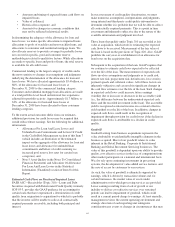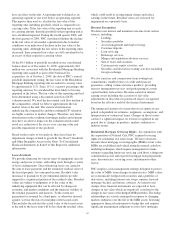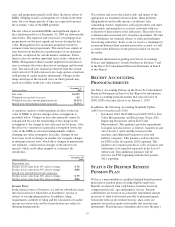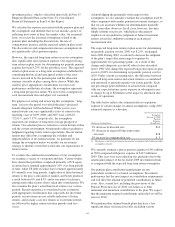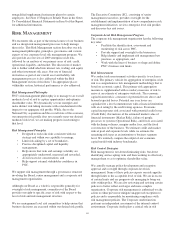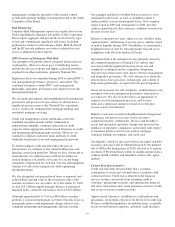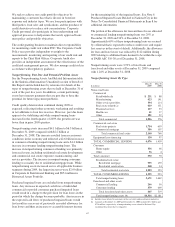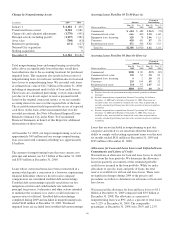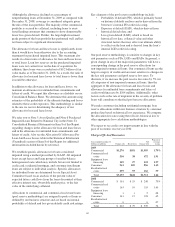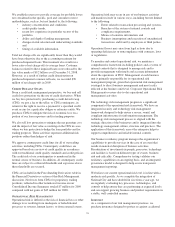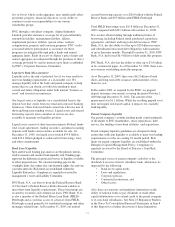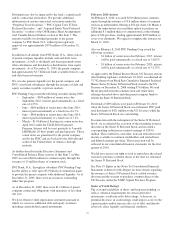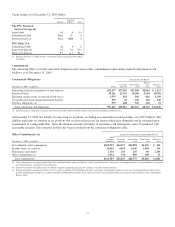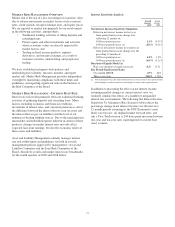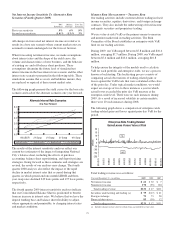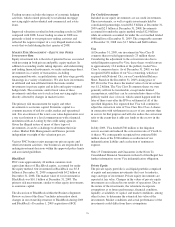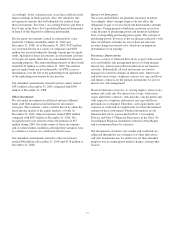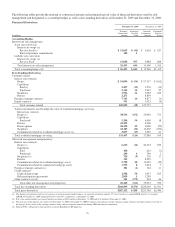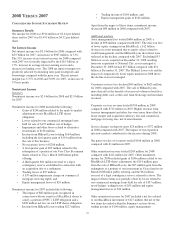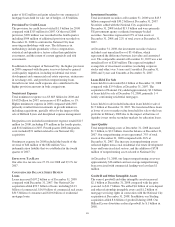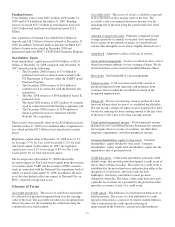PNC Bank 2009 Annual Report Download - page 75
Download and view the complete annual report
Please find page 75 of the 2009 PNC Bank annual report below. You can navigate through the pages in the report by either clicking on the pages listed below, or by using the keyword search tool below to find specific information within the annual report.loss or losses which, in the aggregate, may significantly affect
personnel, property, financial objectives, or our ability to
continue to meet our responsibilities to our various
stakeholder groups.
PNC, through a subsidiary company, Alpine Indemnity
Limited, provides insurance coverage for its general liability,
automobile liability, management liability, fidelity,
employment practices liability, special crime, workers’
compensation, property and terrorism programs. PNC’s risks
associated with its participation as an insurer for these
programs are mitigated through policy limits and annual
aggregate limits. Risks in excess of Alpine’s policy limits and
annual aggregates are mitigated through the purchase of direct
coverage provided by various insurers up to limits established
by PNC’s Corporate Insurance Committee.
L
IQUIDITY
R
ISK
M
ANAGEMENT
Liquidity risk is the risk of potential loss if we were unable to
meet our funding requirements at a reasonable cost. We
manage liquidity risk at the bank and parent company to help
ensure that we can obtain cost-effective funding to meet
current and future obligations under both normal “business as
usual” and stressful circumstances.
Our largest source of liquidity on a consolidated basis is the
deposit base that comes from our retail and corporate banking
businesses. Other borrowed funds come from a diverse mix of
short and long-term funding sources. Liquid assets and unused
borrowing capacity from a number of sources are also
available to maintain our liquidity position.
Liquid assets consist of short-term investments (Federal funds
sold, resale agreements, trading securities, and interest-earning
deposits with banks) and securities available for sale. At
December 31, 2009, our liquid assets totaled $59.8 billion,
with $23.4 billion pledged as collateral for borrowings, trust,
and other commitments.
Bank Level Liquidity
Spot and forward funding gap analyses are the primary metrics
used to measure and monitor bank liquidity risk. Funding gaps
represent the difference in projected sources of liquidity available
to offset projected uses. We calculate funding gaps for the
overnight, thirty day, ninety day, one-hundred eighty day and one
year time intervals. Risk limits are established within the
Liquidity Risk policy. Compliance is regularly reviewed by
management’s Asset and Liability Committee.
PNC Bank, N.A. can borrow from the Federal Reserve Bank
of Cleveland’s (Federal Reserve Bank) discount window to
meet short-term liquidity requirements. These borrowings are
secured by securities and commercial loans. PNC Bank, N.A.
is also a member of the Federal Home Loan Bank (FHLB)-
Pittsburgh and as such has access to advances from FHLB-
Pittsburgh secured generally by residential mortgage and other
mortgage-related loans. At December 31, 2009, our unused
secured borrowing capacity was $26.0 billion with the Federal
Reserve Bank and $9.3 billion with FHLB-Pittsburgh.
Total FHLB borrowings were $10.8 billion at December 31,
2009 compared with $18.1 billion at December 31, 2008.
We can also obtain funding through traditional forms of
borrowing, including Federal funds purchased, repurchase
agreements, and short and long-term debt issuances. PNC
Bank, N.A. has the ability to offer up to $20 billion in senior
and subordinated unsecured debt obligations with maturities
of more than nine months. Through December 31, 2009, PNC
Bank, N.A. had issued $6.9 billion of debt under this program.
PNC Bank, N.A. also has the ability to offer up to $3.0 billion
of its commercial paper. As of December 31, 2009, there were
no issuances outstanding under this program.
As of December 31, 2009, there were $6.2 billion of bank
short- and long-term debt issuances with maturities of less
than one year.
In December 2009, as required by the FDIC, we prepaid
deposit insurance assessments covering the period October 1,
2009 through December 31, 2012. The amount of the
prepayment was $1.1 billion. While the resulting prepaid asset
does not require risk-based capital, it impacts our available
bank liquidity.
Parent Company Liquidity
Our parent company’s routine funding needs consist primarily
of dividends to PNC shareholders, share repurchases, debt
service, the funding of non-bank affiliates, and acquisitions.
Parent company liquidity guidelines are designed to help
ensure that sufficient liquidity is available to meet our funding
requirements over the succeeding 24-month period. Risk
limits for parent company liquidity are established within the
Enterprise Capital Management Policy. Compliance is
regularly reviewed by the Board of Director’s Joint Risk
Committee.
The principal source of parent company cash flow is the
dividends it receives from its subsidiary bank, which may be
impacted by the following:
• Bank-level capital needs,
• Laws and regulations,
• Corporate policies,
• Contractual restrictions, and
• Other factors.
Also, there are statutory and regulatory limitations on the
ability of national banks to pay dividends or make other
capital distributions or to extend credit to the parent company
or its non-bank subsidiaries. See Note 23 Regulatory Matters
in the Notes To Consolidated Financial Statements in Item 8
of this Report for a further discussion of these limitations.
71


